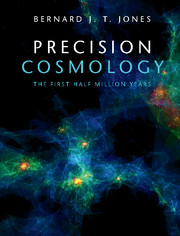Book contents
- Frontmatter
- Dedication
- Contents
- Preface
- Notation and Conventions
- Part I 100 Years of Cosmology
- Part II Newtonian Cosmology
- Part III Relativistic Cosmology
- Part IV The Physics of Matter and Radiation
- 19 Physics of the CMB Radiation
- 20 Recombination of the Primeval Plasma
- 21 CMB Polarisation
- 22 CMB Anisotropy
- Part V Precision Tools for Precision Cosmology
- Appendix A SI, CGS and Planck Units
- Appendix B Magnitudes and Distances
- Appendix C Representing Vectors and Tensors
- Appendix D The Electromagnetic Field
- Appendix E Statistical Distributions
- Appendix F Functions on a Sphere
- Appendix G Acknowledgements
- References
- Index
20 - Recombination of the Primeval Plasma
from Part IV - The Physics of Matter and Radiation
Published online by Cambridge University Press: 04 May 2017
- Frontmatter
- Dedication
- Contents
- Preface
- Notation and Conventions
- Part I 100 Years of Cosmology
- Part II Newtonian Cosmology
- Part III Relativistic Cosmology
- Part IV The Physics of Matter and Radiation
- 19 Physics of the CMB Radiation
- 20 Recombination of the Primeval Plasma
- 21 CMB Polarisation
- 22 CMB Anisotropy
- Part V Precision Tools for Precision Cosmology
- Appendix A SI, CGS and Planck Units
- Appendix B Magnitudes and Distances
- Appendix C Representing Vectors and Tensors
- Appendix D The Electromagnetic Field
- Appendix E Statistical Distributions
- Appendix F Functions on a Sphere
- Appendix G Acknowledgements
- References
- Index
Summary
The transition the Universe makes from a fully ionised plasma to a neutral gas happens very quickly when the age of the Universe is around 380 000 years, i.e. a redshift of z ~ 1500. From our point of view, looking out into the distant Universe, and hence into the past, we see this as a cosmic photosphere. This is referred to as the surface of last scattering since this corresponds to the time after which most of the CMB photons travel freely towards us. The event of the Universe becoming neutral is referred to as the epoch of recombination.
The image of this surface we create with our radiometers is a snapshot of the Universe as it was when it was still only slightly inhomogeneous: we see the initial conditions for the birth of cosmic structure.
Recombination
The photons of the CMB that we observe come from the epoch at a redshift z ~ 1090 when the cosmic plasma was almost neutral and the timescale for electron–photon collisions became longer than the cosmic expansion timescale. The Universe was then some ~ 380 000 years old. Prior to that time, electrons and photons had been held in thermodynamic equilibrium by the Thomson scattering process, while after that time the baryonic component of the cosmic plasma could evolve as an independent component of the plasma.
This was the time of the decoupling of matter from the radiation field. Shortly after that time most of the CMB photons were able to travel directly to us now without being scattered by free electrons. This gave us a direct view of the early conditions that led to the formation of the cosmic structures we see today, the galaxies, clusters of galaxies and their organisation into what is now known as the ‘cosmic web’.
The Universe did not suddenly become neutral as it emerged from the fully ionised fire-ball phase of the cosmic expansion. The neutralisation, or ‘recombination’, of the cosmic plasma took place over several tens of thousands of years. That is enough to slightly blur the details of the structure that might be observed on the last scattering surface: we are looking into the cosmic photosphere.
- Type
- Chapter
- Information
- Precision CosmologyThe First Half Million Years, pp. 476 - 490Publisher: Cambridge University PressPrint publication year: 2017



